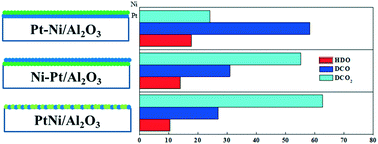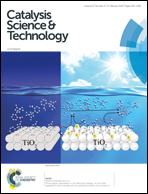Tuning the decarboxylation selectivity for deoxygenation of vegetable oil over Pt–Ni bimetal catalysts via surface engineering†
Abstract
Alloy and bimetal structures are particularly important in developing highly active catalysts for energy conversion. Herein, Pt-skin (Ni–Pt/Al2O3), Ni-skin (Pt–Ni/Al2O3) and NiPt-skin (NiPt/Al2O3) catalysts were designed and synthesized by sequential impregnation of Pt and Ni on Al2O3. The surface structures of these catalysts were confirmed by cyclic voltammetry (CV), X-ray photoelectron spectroscopy (XPS), X-ray diffraction (XRD), N2 adsorption and desorption isotherm measurement (N2-BET) and H2 temperature programmed reduction (H2-TPR). The Pt electronic states were tuned by the sub-layer of Ni on the catalyst's surface which was the key factor to decarboxylation. The NiPt alloy species was formed in the Ni–Pt/Al2O3 and NiPt/Al2O3 catalysts, and these two catalysts contained a higher content of Pt4+ species compared with the Pt–Ni/Al2O3 catalyst. The NiPt-skin catalyst (NiPt/Al2O3) showed the highest catalytic activity for decarboxylation (62%), while the Ni-skin catalyst had the highest decarbonylation selectivity (58%).



 Please wait while we load your content...
Please wait while we load your content...